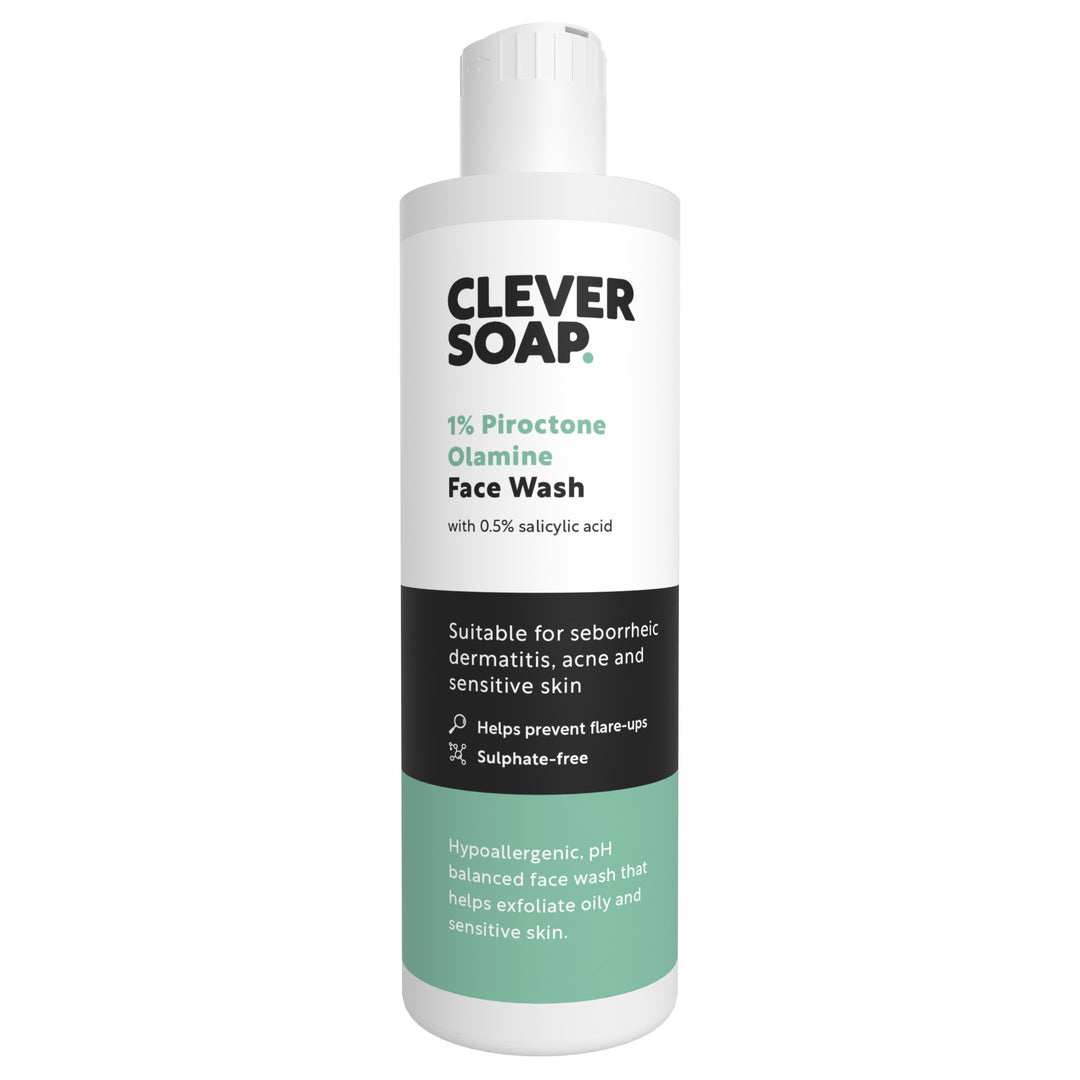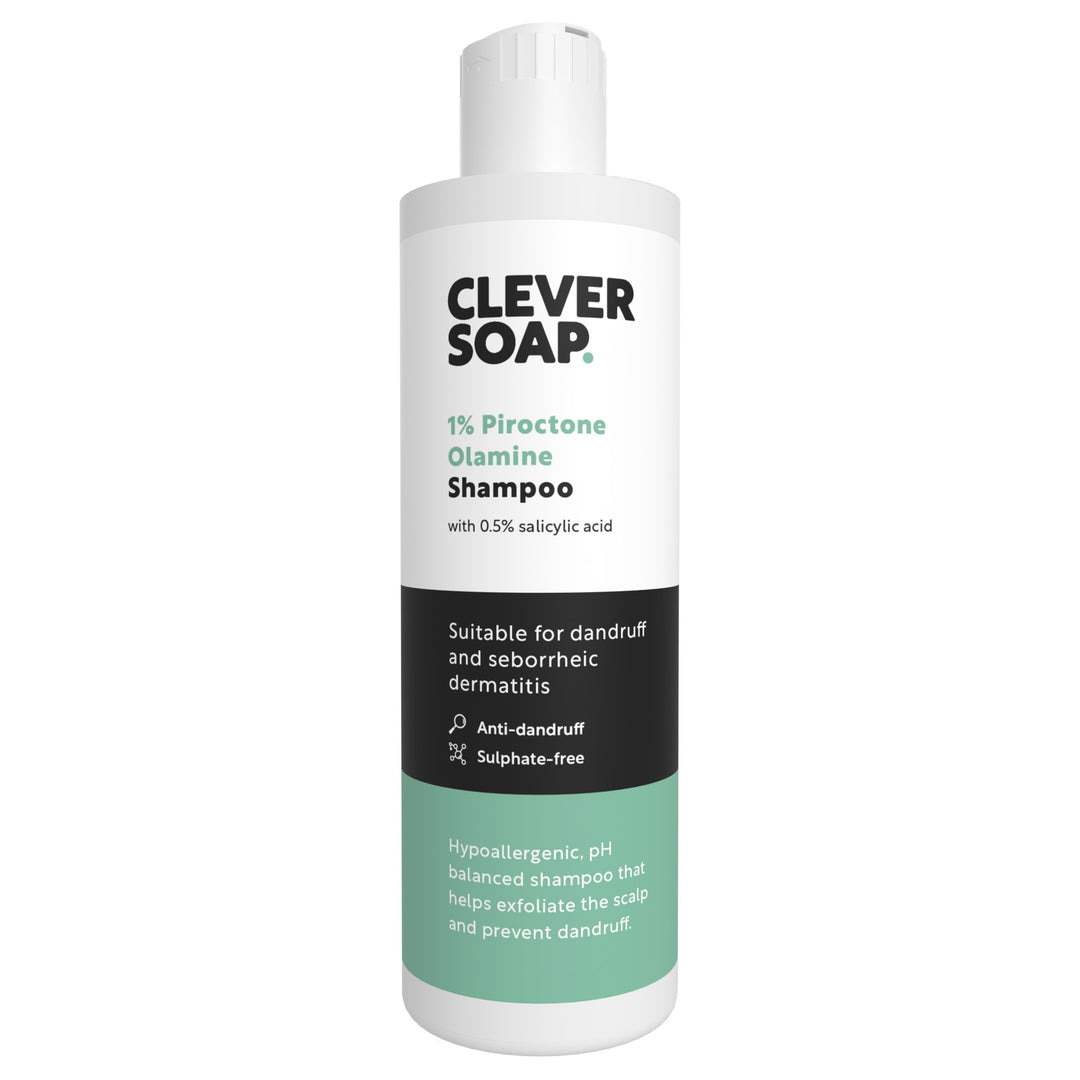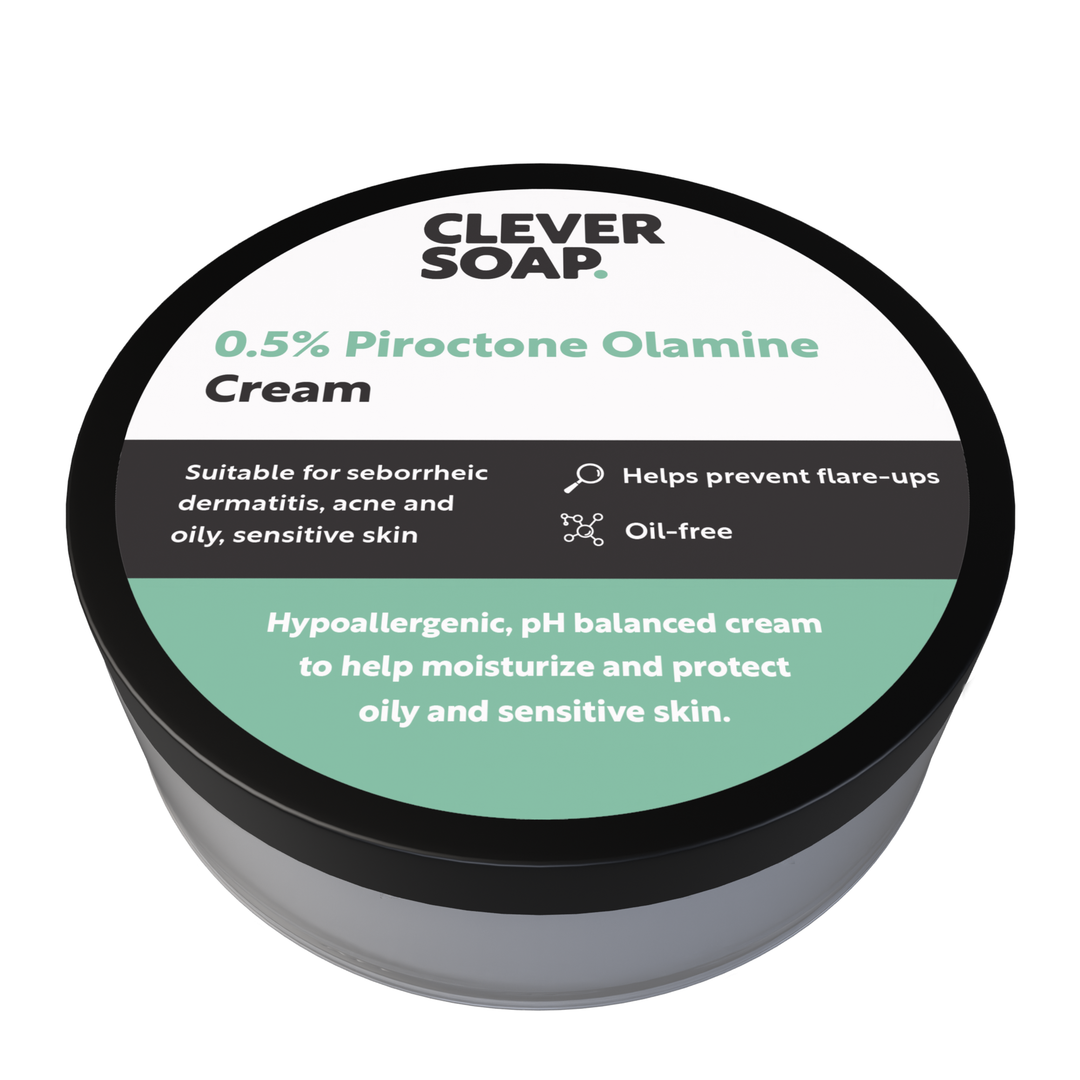U.K. DELIVERY £1.99, FREE FOR ORDERS OVER £25 | INTERNATIONAL DELIVERY FROM £9.99

Tinea Versicolor
Tinea versicolor, also known as pityriasis versicolor, is a common fungal skin infection caused by the overgrowth of a naturally occurring yeast called Malassezia. While this yeast is typically harmless and lives on everyone’s skin, certain conditions can cause it to grow out of control, leading to noticeable changes in skin pigmentation. This results in small, discoloured patches that can appear lighter or darker than the surrounding skin.
The condition is not harmful or contagious, but it can cause cosmetic concerns for those affected. The patches are most commonly found on areas like the chest, back, shoulders, and arms. Tinea versicolor is more common in warm, humid climates, but it can affect people anywhere. With the right treatment, the infection can be managed as we’ll discuss later on.
Malassezia-friendly Skincare Suitable For Tinea Versicolor
Products in our green range are formulated without Malassezia-feeding ingredients, sulphates, or fragrances.
Causes of Tinea Versicolor
Tinea versicolor is caused by the overgrowth of a type of yeast called Malassezia, which naturally resides on the surface of the skin. Under normal circumstances, this yeast coexists with your skin’s microbiome without causing any harm. However, certain factors can trigger an overgrowth, leading to the appearance of tinea versicolor. It’s also the cause of a number of other skin conditions such as seborrheic dermatitis.
Warm and Humid Environments
The yeast thrives in warm, moist conditions, which is why tinea versicolor is more common in tropical or subtropical climates. People living in or frequently visiting these areas may experience flare-ups during hot and humid seasons [1].

Oily Skin & Comedogenic Skincare Products
Excess oil production creates an ideal environment for the yeast to grow. Individuals with naturally oily skin may be more prone to developing tinea versicolor, as the excess sebum allows the yeast to proliferate more easily. For this reason, using oily skincare products can also exacerbate the problem [2].
Hormonal Changes
Hormonal fluctuations, particularly during adolescence, pregnancy, or times of stress, can influence the skin’s oil production, leading to an imbalance and giving the yeast an opportunity to grow [3].
Weakened Immune System
A weakened immune system, whether due to illness, medication, or a medical condition, can make it harder for your body to keep Malassezia yeast in check. This can lead to a higher likelihood of developing tinea versicolor [1].
Symptoms of Tinea Versicolor
Tinea versicolor is most recognizable by its effect on skin pigmentation. While it doesn’t cause any serious health issues, the visual changes it brings can be concerning for those affected. The symptoms tend to be subtle at first but become more noticeable over time, particularly in areas where the yeast overgrowth occurs.
Discolored Patches
The most obvious symptom of tinea versicolor is the appearance of small, discolored patches on the skin. These patches can range in colour, often appearing as:
• Lighter than the surrounding skin (hypopigmentation).
• Darker than the surrounding skin (hyperpigmentation).
• Pink, red, tan, or brown, depending on the individual’s skin tone.
Commonly Affected Areas
Tinea versicolor typically affects areas of the body where there is more sebaceous activity (oil production) and where the skin tends to stay warm and moist. The most commonly affected areas include:
• Chest
• Back
• Shoulders
• Upper arms
• Neck
In some cases, patches can spread to the face or lower parts of the body, but this is less common.
Itching and Irritation
Although tinea versicolor doesn’t usually cause severe discomfort, some people may experience mild itching, especially when sweating or spending time in hot environments. The affected skin may also feel slightly dry or flaky.
Scaling or Flaking
In some cases, the discoloured patches may develop a subtle scaling texture. This is more common when the skin is dry or after using antifungal treatments. The patches can feel slightly rough or flaky to the touch.
Lack of Tanning
One characteristic of tinea versicolor is that the affected areas of skin do not tan as evenly as the rest of the skin when exposed to sunlight. This can cause the patches to become more noticeable after sun exposure, especially in individuals with naturally darker skin tones.
Skin Conditions That Can Be Confused with Tinea Versicolor
Tinea versicolor shares some similarities with several other skin conditions, making it easy to mistake for other issues. Proper diagnosis is essential for effective treatment, so it’s important to understand the conditions that can be confused with tinea versicolor.
Vitiligo. Vitiligo is a condition where the skin loses its pigment in patches due to the destruction of melanocytes (the cells responsible for skin color). However, unlike tinea versicolor, which is caused by a fungal infection, vitiligo is an autoimmune disorder. The patches in vitiligo are typically larger, more symmetrical, and do not cause itching or scaling. Additionally, vitiligo patches do not tan, while tinea versicolor patches may become more noticeable after sun exposure.
Pityriasis Alba. Pityriasis alba is a common skin condition that primarily affects children and adolescents. It causes lighter, scaly patches, particularly on the face. The patches in pityriasis alba are usually more diffuse, appearing mostly on the face, whereas tinea versicolor tends to affect the chest, back, and shoulders. Pityriasis alba also tends to resolve on its own over time, without the need for antifungal treatment.
Seborrheic Dermatitis. Seborrheic dermatitis is a chronic skin condition that causes red, inflamed, and scaly patches, primarily in oily areas of the skin, such as the scalp, face, and chest. While both conditions are linked to Malassezia yeast, seborrheic dermatitis is more likely to cause redness, inflammation, and greasy scaling, whereas tinea versicolor typically causes discolored patches without significant redness or irritation.

Post-Inflammatory Hypopigmentation. This occurs when an area of skin becomes lighter after an injury, inflammation, or irritation due to the loss of melanin. It's typically linked to a specific event (e.g., a cut, burn, or skin condition like eczema), whereas tinea versicolor develops gradually due to fungal overgrowth.
Treatments for Tinea Versicolor
Tinea versicolor is a treatable condition, and with the right approach, most cases can be resolved effectively. Treatment focuses on eliminating the overgrowth of Malassezia yeast and restoring the skin’s natural colour. There are a variety of treatment options available, ranging from over-the-counter topical treatments to prescription medications for more severe or recurrent cases.
Topical Antifungal Treatments
For mild-moderate cases of tinea versicolor, topical treatments are typically the first line of defence. These antifungal agents work by killing the yeast on the skin and stopping its spread.
Antifungal Creams, Lotions, and Washes. Common ingredients include clotrimazole, miconazole, and piroctone olamine. These products are applied directly to the affected areas once or twice a day for several weeks until the infection clears.
Shampoos. Shampoos containing selenium sulfide, ketoconazole, or zinc pyrithione can be used not only on the scalp but also on the body to treat tinea versicolor [4]. These are often applied to the affected skin for 5-10 minutes before rinsing off. This can be done daily for a week or two, depending on the severity of the infection.
Oral Antifungal Medications
For more extensive or recurrent cases of tinea versicolor, dermatologists may prescribe oral antifungal medications. These work by delivering antifungal agents through the bloodstream to target the infection from within. Itraconazole or fluconazole are some examples [4], typically taken for a short period, ranging from a few days to a couple of weeks, depending on the severity of the infection. They are generally more effective than topical treatments for widespread or persistent tinea versicolor. However, they may come with side effects, so they are reserved for more stubborn cases.
Natural and Home Remedies
While not as scientifically proven as antifungal treatments, some natural remedies may provide relief for mild cases or be used alongside conventional treatments. These remedies can help keep the skin clean and reduce yeast overgrowth:
- Coconut Oil: Contains natural antifungal properties due to its high lauric acid content. Applying coconut oil to the affected areas can help inhibit the growth of Malassezia yeast.
- Tea Tree Oil: Known for its antifungal and antibacterial properties. Diluting a few drops of tea tree oil in a carrier oil and applying it to the skin may help control the infection.
- Apple Cider Vinegar: Some people use diluted apple cider vinegar as a topical application to balance skin pH and fight the yeast. However, it can be irritating, so use with caution.
- Sulphur-Containing Thermal Waters. A 2017 study has shown effectiveness of sulphur in treating tinea versicolor [5]. Read our detailed guide on sulphur to learn more.
Once treated, tinea versicolor can recur, especially in individuals who live in warm, humid environments or have naturally oily skin. Preventative measures can help reduce the likelihood of future outbreaks, such as regular use of appropriate washes or shampoos, keeping the skin dry as yeast thrives in moist environments and avoiding excessive sun exposure as this can make the discoloured patches more noticeable.
It’s also worth noting that after the infection has been cleared, the skin may take time to regain its normal pigmentation. In some cases, the discolored patches can remain for weeks or even months after treatment. Some dermatologists may recommend topical treatments such as hydroquinone or retinoids to help speed up the recovery of skin colour.
Best Skincare Routine for Tinea Versicolor
Managing tinea versicolor involves not only anti-fungal treatment but also daily skincare that supports the skin’s microbiome and reduces recurrence. The goal is to gently cleanse the skin, avoid overly greasy products, and use ingredients that won’t encourage the growth of Malassezia yeast.
Morning Routine
- Gentle Cleanser. Use a non-comedogenic, fragrance-free cleanser that won’t leave residue or feed yeast. Our piroctone olamine face wash may help gently exfoliate and maintain balance.
- Anti-fungal Application. If you’ve been prescribed a topical anti-fungal, apply it as directed.
- Lightweight Moisturizer. Opt for an oil-free moisturizer without esters or fatty acids in the C11–C24 range. Our Piroctone Olamine Cream is non-comedogenic and suitable for tinea versicolor.
- Sunscreen. Tinea Versicolor can cause light or dark patches that become more noticeable in the sun. Use a non-comedogenic mineral sunscreen (zinc oxide or titanium dioxide) to protect your skin without feeding yeast. To learn more about the importance of sunscreen, read our guide here.
Evening Routine
- Cleanse Gently. Repeat cleansing with a suitable face wash.
- Targeted Treatment. Reapply topical anti-fungal if directed for evening use.
- Moisturize (Optional). If your skin feels dry, use a Malassezia-safe moisturizer. Avoid rich oils or comedogenic formulas.
Common Myths About Tinea Versicolor
Tinea versicolor is a widely misunderstood skin condition, with a lot of misinformation surrounding it. Here are some of the most common myths about tinea versicolor:
Tinea Versicolor Is Contagious
Tinea versicolor is not contagious. It is caused by an overgrowth of a yeast that naturally lives on everyone’s skin. This yeast only becomes problematic when certain conditions allow it to grow excessively, but it cannot be spread through contact with others.
Only People with Poor Hygiene Get Tinea Versicolor
Tinea versicolor is not linked to poor hygiene. In fact, it can affect anyone, regardless of their personal hygiene habits. Factors like warm, humid environments, oily skin, and hormonal changes are the primary causes, not how clean a person is.

Tinea Versicolor Will Go Away on Its Own
Tinea versicolor typically requires treatment to clear up. While it’s not harmful, the discolored patches will likely persist without the use of topical or oral antifungal treatments. In some cases, untreated tinea versicolor can worsen or spread to larger areas of the skin.
Sun Exposure Can Cure Tinea Versicolor
Sun exposure does not cure tinea versicolor and may actually make the patches more noticeable. The affected areas of skin often don’t tan like the rest of the body, which can cause the discolored patches to stand out even more after sun exposure.
Tinea Versicolor FAQs
What is the fastest way to get rid of tinea versicolor?
Topical anti-fungal treatments are often the best solution, especially when applied consistently. For more severe or recurring cases, oral anti-fungal medication may be prescribed.
How long does tinea versicolor take to clear up?
While the yeast can often be cleared in 1–4 weeks with treatment, the skin discoloration may take longer (up to several months) to fade as the pigment gradually normalizes.
What ingredients should I avoid if I have tinea versicolor?
Avoid comedogenic oils (like coconut or olive oil), fatty acid esters, and thick occlusive products. Malassezia feeds on certain lipids, so avoiding C11–C24 range fatty acids and esters helps minimize flare-ups.
Conclusion
Tinea versicolor is a common skin condition that, while not harmful, can be frustrating due to its visible effects on the skin. Understanding the causes, symptoms, and available treatments is essential to effectively manage the condition and prevent future flare-ups. It’s also important to debunk the myths surrounding tinea versicolor, such as the idea that it’s contagious or caused by poor hygiene.
If you’re prone to tinea versicolor, maintaining a regular skincare routine that includes antifungal products and minimizing excess moisture on the skin can help reduce recurrences. While it may take time for your skin’s pigment to fully return to normal after treatment, the condition is manageable with the right approach. Remember, if you’re unsure about your diagnosis or treatment, consulting a dermatologist or your GP is always a good idea.
References
[1] Leung, Alexander K. C, Benjamin Barankin, Joseph M. Lam, Kin Fon Leong, and Kam Lun Hon, 2022. "Tinea versicolor: an updated review", Drugs in Context, 11:1-20. https://doi.org/10.7573/dic.2022-9-2
[2] Almalki, Marwah khalil I, Ziyad Muharib N Alruwaili, Norah S Alhammad, Toleen M Alawadi, and Mazen S Dajam, 2023. "Tinea versicolor in a three-month infant: a case report and literature review", Cureus. https://doi.org/10.7759/cureus.40763
[3] Mellen, LA, Jeffrey A. Vallee, Steven R. Feldman, and Fleischer Ab, 2004. "Treatment of pityriasis versicolor in the united states", Journal of Dermatological Treatment(3), 15:189-192. https://doi.org/10.1080/09546630410032421
[4] Aleena Nasir, Abdul Haseeb Khan, Ayesha Rizwan, Najia Sajjad, & Sara Sarwar (2023). “Comparison of efficacy of single oral dose fluconazole versus single oral dose itraconazole in patients with pityriasis versicolor”, Annals of PIMS-Shaheed Zulfiqar Ali Bhutto Medical University, 19(3), 318-322. https://doi.org/10.48036/apims.v19i3.816
[5] Hamidizadeh, Nasrin, Shima Simaeetabar, Farhad Handjani, Sara Ranjbar, Mohammad Gohari Moghadam, and Mohammad Mahdi Parvizi, 2017. "Composition of minerals and trace elements at mamasani thermal source: a possible preventive treatment for some skin diseases", Journal of Education and Health Promotion(1), 6:110. https://doi.org/10.4103/jehp.jehp_100_17



